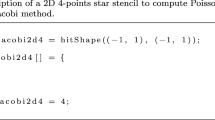Abstract
In the prospect of the upcoming exa-scale era with millions of execution units, the question of how to deal with this level of parallelism efficiently is of time-critical relevance. State-of-the-Art parallelization techniques such as OpenMP and MPI are not guaranteed to solve the expected problems of starvation, growing latencies, overheads, and contention. On the other hand, new parallelization paradigms promise to efficiently hide latencies and contain starvation and contention.
In this paper we analyze the performance of one novel parallelization strategy for shared and distributed memory machines. We will focus on shared memory architectures and compare the performance of the ParalleX execution model against the quasi-standard OpenMP for a standard stencil-based problem. We compare in detail the OpenMP implementation of two applications of Jacobi solvers (one based on regular grid and one based on an irregular grid structure) with the corresponding implementation of these applications using HPX (High Performance ParalleX), the first feature-complete, open-source implementation of ParalleX, and analyze the results of both implementations on a multi-socket NUMA node.













Similar content being viewed by others
References
Kaiser H, Brodowicz M, Sterling T (2009) ParalleX: An advanced parallel execution model for scaling-impaired applications. In: Parallel processing workshops. IEEE Computer Society, Los Alamitos, pp 394–401. doi:10.1109/ICPPW.2009.14
Brookes SD, Hoare CAR, Roscoe AW (1984) A theory of communicating sequential processes. J ACM 31(3):560–599
Message Passing Interface Forum (2009) MPI: a message-passing interface standard, version 2.2. High Performance Computing Center Stuttgart (HLRS), Stuttgart, Germany
Dagum L, Menon R (1998) OpenMP: An industry-standard API for shared-memory programming. IEEE Comput Sci Eng 5(1):46–55. doi:10.1109/99.660313
STE||AR Group (2011) Systems Technologies, Emerging Parallelism, and Algorithms Research. http://stellar.cct.lsu.edu
Anderson M, Brodowicz M, Kaiser H, Sterling TL (2011) An application driven analysis of the ParalleX execution model. CoRR abs/1109.5201. http://arxiv.org/abs/1109.5201
Boost: a collection of free peer-reviewed portable C++ source libraries (2011). http://www.boost.org/. http://www.boost.org/
Baker HC, Hewitt C (1977) The incremental garbage collection of processes. In: SIGART bull. ACM Press, New York, pp 55–59. doi:10.1145/872736.806932. 10.1145/872736.806932
Friedman DP, Wise DS (1976) Cons should not evaluate its arguments. In: ICALP, pp 257–284
Papadopoulos G, Culler D (1990) Monsoon: an explicit token-store architecture. In: 17th International symposium on computer architecture, no. 18(2) in ACM SIGARCH computer architecture news, May 28–31. ACM Digital Library, Seattle, Washington,
Barrett R, Berry M, Chan TF, Demmel J, Donato J, Dongarra J, Eijkhout V, Pozo R, Romine C, der Vorst HV (1994) Templates for the solution of linear systems: building blocks for iterative methods, 2nd edn. SIAM, Philadelphia
Hager G, Wellein G (2010) Introduction to high performance computing for scientists and engineers, 1st edn. CRC Press, Boca Raton
Janna C, Ferronato M (2011) Janna/Serena sparse matrix. http://www.cise.ufl.edu/research/sparse/matrices/Janna/Serena.html
Ferronato M, Gambolati G, Janna C, Teatini P (2010) Geomechanical issues of anthropogenic CO2 sequestration in exploited gas fields. Energy Convers Manag 51(10):1918–1928. doi:10.1007/s00450-012-0217-1
Triebig J (2012) Likwid: Linux tools to support programmers in developing high performance multi-threaded programs. http://code.google.com/p/likwid/
McCalpin JD (2012) STREAM: Sustainable memory bandwidth in high performance computers. A continually updated technical report, University of Virginia, Charlottesville, VA (1991–2007). http://www.cs.virginia.edu/stream/
Acknowledgements
We thank Matthew Anderson for helpful discussions and for preparing the irregular grids we used. We thank Georg Hager for optimizing the OpenMP usage and for suggesting the applied performance model. We acknowledge the support from the Center for Computation and Technology (CCT) at Louisiana State University (LSU) and from NSF grants (1029161, 1117470) to LSU.
Author information
Authors and Affiliations
Corresponding author
Rights and permissions
About this article
Cite this article
Heller, T., Kaiser, H. & Iglberger, K. Application of the ParalleX execution model to stencil-based problems. Comput Sci Res Dev 28, 253–261 (2013). https://doi.org/10.1007/s00450-012-0217-1
Published:
Issue Date:
DOI: https://doi.org/10.1007/s00450-012-0217-1




